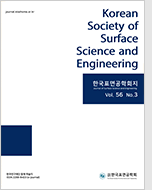
- Past Issues
- e-Submission
-

2021 Impact Factor 1.766
5-Year Impact Factor 1.674
Editorial Office
- +82-2-563-0935
- +82-2-558-2230
- submission@kssse.or.kr
- https://www.kssse.or.kr/

2021 Impact Factor 1.766
5-Year Impact Factor 1.674
The Korean Society of Surface Science and Engineering 2024;57(4):274-284. Published online: Sep, 9, 2024
DOI : 10.5695/JSSE.2024.57.4.274
In this study, copper foil was electroplated under high current density conditions. We used Polyethylene Glycol (PEG), known for its thermal stability and low decomposition rate, as an inhibitor to form a stable and smooth copper layer on the titanium cathode. The electrolyte was composed of 50 g/L CuSO4 and 100 g/L H2SO4, MPSA as an accelerator, JGB as a leveler, and PEG as a suppressor, and HCl was added as chloride ions for improving plating efficiency. The copper foil electroplated in the electrolyte added PEG which induced to inhibit the growth of rough crystals. As a result, the surface roughness value was reduced, and a uniform surface was formed over a large area. Moreover, the addition of PEG led to priority growth to the (111) plane and the formation of polygonal crystals through horizontal and vertical growth of crystals onto the cathode. In addition, the grains became fine when more than 30 ppm of PEG was added. As the microcrystalline structure changed, mechanical and electrical properties were altered. With the addition of PEG, the tensile strength increased due to grain refinement, and the elongation was improved due to the uniform surface. However, as the amount of PEG added increased, the corrosion rate and resistivity increased due to grain refinement. Finally, it was possible to manufacture a copper foil with excellent electrical and mechanical properties and the best surface properties when electroplating was carried out under the condition of additives with Cl- 20 ppm, MPSA 10 ppm, JGB 5 ppm, and PEG 10 ppm.
Keywords Indole-3-Acetic Acid, Electrochemical sensor, Reduced graphene oxide aerogel, Conducting polymer composite, Polyethyleneimine